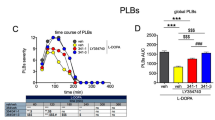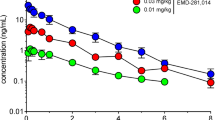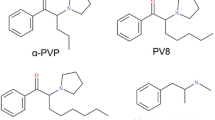Abstract
This study examined the interaction between various glutamate antagonists and selective D1 (SKF 38393) and D2 (RU 24213) dopamine agonists in the production of locomotion in the reserpine-treated mouse. Firstly, in normal mice, the NMDA channel blocker MK 801 (0.1–1.6 mg/kg) caused a biphasic stimulation/depression of locomotor activity, whereas the competitive NMDA antagonists CGP 40116 (0.25–8 mg/kg) and CPP (0.2–20 mg/kg), and the NMDA glycine site antagonist HA 966 (0.4–10 mg/kg) inhibited locomotion monophasically. These compounds caused varying degrees of muscle weakness and impairment of posture and gait, whilst the AMPA receptor blocker NBQX (0.2–25 mg/kg) had no significant effect on unconditioned mouse motor behaviour. None of the antagonists reversed reserpine-induced akinesia by themselves, but they all potentiated the locomotor movements induced by 30 mg/kg SKF 38393. Movements remained fluent with low doses of CPP, HA 966 and NBQX, but became ataxic with MK 801 and CGP 40116, with sedation prevailing at high doses of all the antagonists, as in normal mice. CPP and NBQX also combined synergistically with SKF 38393 to promote tonic convulsions. By contrast, RU 24213-induced locomotion was dose-dependently depressed by MK 801, CGP 40116 and HA 966, but was unaffected by CPP or NBQX. These differential effects of NMDA and AMPA antagonists on D1 and D2 motor responding in the monoamine-depleted mouse are discussed in terms of possible mechanisms and sites of action within the brain, and the implications for their putative use as adjuvants tol-dopa in antiparkinson therapy.
Similar content being viewed by others
References
Al-Tajir G, Chandler CJ, Starr BS, Starr MS (1990) Opposite effects of stimulation of D1 and D2 dopamine receptors on the expression of motor seizures in mouse and rat. Neuropharmacology 29:657–661
Bergman H, Wichmann T, DeLong MR (1990) Reversal of experimental parkinsonism by lesions of the subthalamic nucleus. Science 249:1436–1438
Brotchie JM, Mitchell IJ, Sambrook MA, Crossman AR (1991) Alleviation of parkinsonism by antagonism of excitatory amino acid transmission in the medial segment of the globus pallidus in rat and primate. Mov Disord 6:133–138
Campbell GA, Eckhardt MJ, Weight FF (1985) Dopaminergic mechanisms in subthalamic nucleus of rat: analysis using horse-radish peroxidase and microiontophoresis. Brain Res 333:261–270
Carlsson M, Carlsson A (1989a) Dramatic synergism between MK-801 and clonidine with respect to locomotor stimulatory effect in monoamine-depleted mice. J Neural Transm 77:65–71.
Carlsson M, Carlsson A (1989b) The NMDA antagonist MK-801 causes marked locomotor stimulation in monoamine-depleted mice. J Neural Transm 75:221–226
Carlsson M, Svensson A (1990a) Interfering with glutamatergic neurotransmission by means of NMDA antagonist administration discloses the locomotor stimulatory potential of other transmitter systems. Pharmacol Biochem Behav 36:45–50
Carlsson M, Svensson A (1990b) The non-competitive NMDA antagonists MK-801 and PCP, as well as the competitive NMDA antagonist SDZ EAA494 (D-CPPene), interact synergistically with clonidine to promote locomotion in monoamine-depleted mice. Life Sci 47:1729–1736
Crossman AR, Peggs D, Boyce S, Luquin MR, Sambrook MA (1989) Effect of the NMDA antagonist MK-801 on MPTP-induced parkinsonism in the monkey. Neuropharmacology 28:1271–1273
Davies J, Evans RH, Herrling PL, Jones AW, Olverman HJ, Pook P, Watkins JC (1986) CPP, a new potent and selective NMDA antagonist. Depression of central neuron responses, affinity for [3H] D-AP5 binding sites on brain membranes and anticonvulsant activity. Brain Res 382:169–173.
Domino E, Sheng J (1993)N-Methyl-d-aspartate receptor antagonist and dopamine D1 and D2 agonist interactions in 1-methyl-4-phenyl-1,2,3,6-tetrahydropyridine-induced hemiparkinsonian monkeys. J Pharmacol Exp Ther 264:221–225
Euvrard C, Ferland L, Di Paulo T, Beaulieu M, Labrie F, Oberlander C, Raynaud JP, Boissier JR (1980) Activity of two new potent dopaminergic agonists at the striatal and pituitary levels. Neuropharmacology 19:379–386.
Filion M (1979) Effects of interruption of the nigrostriatal pathway and of dopaminergic agents on the spontaneous activity of globus pallidus neurons in the awake monkey. Brain Res 178:425–441
Filion M, Tremblay L, Bedard PJ (1991) Effects of dopamine agonists on the spontaneous activity of globus pallidus neurons in monkeys with MPTP-induced parkinsonism. Brain Res 547:152–161
Fletcher EJ, Lodge D (1988) Glycine reverses antagonism ofN-methyl-d-aspartate (NMDA) by 1-hydroxy-3-aminopyrrolidone-2 (HA 966) but not byd-2-amino-5-phosphonovalerate (d-AP5) on rat cortical slices. Eur J Pharmacol 151:161–162
Geffen LB, Jessell TM, Cuello AC, Iversen LL (1976) Release of dopamine from dendrites in rat substantia nigra. Nature 260:258–260
Gerfen CR, Engber TM, Mahan LC, Susel Z, Chase TN, Monsma FJ, Sibley DR (1990) D1 and D2 dopamine receptor-regulated gene expression of striatonigral and striatopallidal neurons. Science 250:1429–1432
Girault JA, Halpain S, Greengard P (1990) Excitatory amino acid antagonists and Parkinson's disease. Trends Neurosci 13:325–326
Goodwin P, Starr BS, Starr MS (1992) Motor responses to dopamine D1 and D2 agonists in the reserpine-treated mouse are affected differentially by the NMDA receptor antagonist MK 801. J Neural Transm (P-D Sect) 4:15–26
Greenamayre JT, O'Brien CF (1991)N-Methyl-d-aspartate antagonists in the treatment of Parkinson's disease. Arch Neurol 48:977–981
Honoré T, Davies SN, Drejer J, Fletcher EJ, Jacobsen P, Lodge D, Nielsen FE (1988) Quinoxalinediones: potent competitive non-NMDA glutamate receptor antagonists. Science 241:701–703
Klockgether T, Turski L (1989) Excitatory amino acids and the ‘basal ganglic: implications for the therapy of Parkinson's disease. Trends Newosci 12:285–286
Klockgether T, Turski L (1990) NMDA antagonists potentiate antiparkinsonian actions ofl-dopa in monoamine-depleted rats. Ann Neurol 28:539–546
Klockgether T, Turski L, Honoré T, Zhang Z, Gash DM, Kurlan R, Greenamayre T (1991) The AMPA receptor antagonist NBQX has antiparkinsonian effects in monoamine-depleted rats and MPTP-treated monkeys. Ann Neurol 30:717–723
Lindvall O, Björklund A (1979) Dopaminergic innervation of the globus pallidus by collaterals from the nigrostriatal pathway. Brain Res 172:169–173
Löschmann PA, Lange KW, Kunow M, Rettig KJ, Jähnig P, Honoré T, Turski L, Wachtel H, Jenner P, Marsden CD (1991) Synergism of the AMPA-antagonist NBQX and the NMDA-antagonist CPP withl-dopa in models of Parkinson's disease. J Neural Transm [P-D Sect] 3:203–213
Luquin MR, Obeso JA, Laguna J, Guillen J, Martinez-Lage JM (1993) The AMPA receptor antagonist NBQX does not alter the motor response induced by selective dopamine agonists in MPTP-treated monkeys. Eur J Pharmacol 235:297–300
Miller WC, DeLong MR (1987) Altered tonic activity of neurons in the globus pallidus and subthalamic nucleus in the primate MPTP model of parkinsonism. Adv Behav Biol 32:395–405
Mitchell IJ, Clarke CE, Boyce S, Robertson RG, Peggs D, Sambrook MA, Crossman AR (1989) Neural mechanisms underlying parkinsonian symptoms based upon regional uptake of 2-deoxyglucose in monkeys exposed to 1-methyl-4-phenyl-1,2,3,6-tetrahydropyridine (MPTP). Neuroscience 32:213–226
Morelli M, Di Chiara G (1990) MK-801 potentiates dopaminergic D1 but reduces D2 responses in the 6-hydroxydopamine model of Parkinson's disease. Eur J Pharmacol 182:611–612
Morelli M, Fenu S, Pinna A, Di Chiara G (1992) Opposite effects of NMDA receptor blockade on dopaminergic D1- and D2- mediated behaviour in the 6-hydroxydopamine model of turning: relationship with c-fos expression. J Pharmacol Exp Ther 260:402–408
Ohno Y, Sasa M, Takaori S (1987) Coexistence of inhibitory dopamine D-1 and excitatory D-2 receptors on the same caudate nucleus neurons. Life Sci 40:1937–1945
Robertson GS, Robertson HA (1986) Synergistic effects of D1 and D2 dopamine agonists on turning behaviour in rats. Brain Res 384:387–390
Robertson GS, Vincent SR, Fibiger HC (1990) Striato-nigral projection neurons contain D1 receptor-activated c-fos. Brain Res 523:288–2901
Rouillard C, Bedard PJ (1988) Specific D1 and D2 dopamine agonists have synergistic effects in the 6-hydroxydopamine circling model in the rat. Neuropharmacology 27:1257–1264
Rouzaire-Dubois B, Scarnati E (1987) Pharmacological study of the cortical-induced excitation of subthalamic nucleus neurons in the rat: evidence for amino acids as putative neurotransmitters. Neuroscience 21:429–440
Schmidt WJ, Bubser M, Hauber W (1990) Excitatory amino acids and Parkinson's disease. Trends Neurosci 13:46–47
Schmutz M, Jeker A, Klebs K, Portet C, Pozza M, Fagg GE, Heckendorn R, Allgeier H (1991) CGP 40116/CGP 43487:competitive-N-methyl-d-aspartate receptor antagonists with potent oral anticonvulsant activity. Epilepsia 32 [Suppl 1]:59–60
Setler P, Sarau HM, Zirkle CL, Saunders HL (1978) The central effects of a novel dopamine agonist. Eur J Pharmacol 50:419–430
Starr BS, Starr MS (1986) Differential effects of dopamine D1 and D2 agonists and antagonists on velocity of movement, rearing and grooming in the mouse. Neuropharmacology 25:455–463
Turski L, Schwarz M, Turski WA (1985) Muscle relaxant action of excitatory amino acid antagonists. Neurosci Lett 53:321–326
Wachtel H, Kunow M, Löschmann PA (1992) NBQX (6-nitrosulfamoyl-benzo-quinoxaline-dione) and CPP (3-carboxypiperazin-propyl phosphonic acid) potentiate dopamine agonist induced rotations in substantia nigra lesioned rats. Neurosci Lett 142:179–182
Wamsley JK, Gehlert DR, Filloux FM, Dawson TM (1989) Comparison of the distribution of D-1 and D-2 dopamine receptors in the rat brain. J Chem Neuroanat 2:119–137
Wassef M, Berod A, Sotelo C (1981) Dopaminergic dendrites in the pars reticulata of the rat substantia nigra and their striatal input. Combined immunocytochemical localization of tyrosine hydroxylase and antergrade degeneration. Neuroscience 6:2125–2139
Watkins JC, Krogsgaard-Larsen P, Honoré T (1990) Structure-activity relationships in the development of excitatory amino acid receptor agonists and competitive antagonists. Trends Neuro sci 11:25–33
Wong EHF, Kemp JA (1991) Sites for antagonism on theN-methyl-d-aspartate receptor channel complex. Annu Rev Pharmacol Toxicol 31:401–425
Wong EHF, Kemp JA, Priestly T, Knight AR, Woodruff GN, Iversen LL (1988) The anticonvulsant MK-801 is a potentN-methyl-d-aspartate antagonist. Proc Natl Acad Sci USA 83:7104
Wüllner U, Kupsch A, Arnold G, Renner P, Scheid C, Oertel W, Klockgether T (1992) The competitive NMDA antagonist CGP 40116 enhancesl-dopa response in MPTP-treated marmosets. Neuropharmacology 31:713–715
Young AB, Dauth GW, Hollingsworth Z, Penny JB, Kaatz K, Gilman S (1990) Quisqualate- and NMDA-sensitive [3H] glutamate binding in primate brain. J Neurosci Res 27:512–521
Author information
Authors and Affiliations
Rights and permissions
About this article
Cite this article
Starr, M.S., Starr, B.S. Comparison of the effects of NMDA and AMPA antagonists on the locomotor activity induced by selective D1 and D2 dopamine agonists in reserpine-treated mice. Psychopharmacology 114, 469–476 (1994). https://doi.org/10.1007/BF02249338
Received:
Accepted:
Issue Date:
DOI: https://doi.org/10.1007/BF02249338




